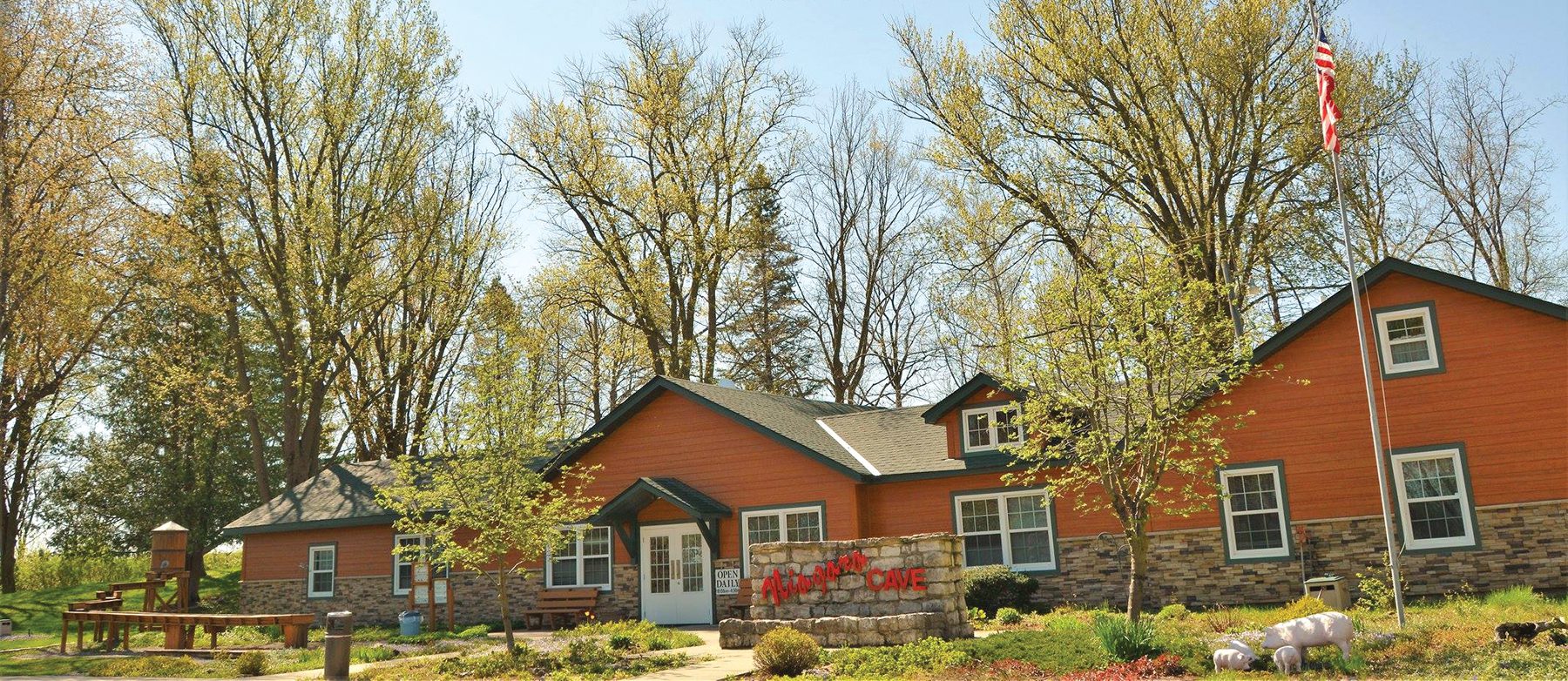100 Years of Niagara Cave
It was three pigs that went missing from farmer Phil Tod’s barnyard in 1924 that led to the discovery of one of Southeast Minnesota’s greatest natural treasures: Niagara Cave!

“After a quick look around, Phil sent his nephews and a hired hand to look for them. Their search led to a large sinkhole on the property where lo and behold, a two-foot-by-four-foot hole in the bottom of the sinkhole seemed telling. With the help of ropes, lanterns, and several men from Harmony, one of the gents was lowered over 60 feet down where he found all three pigs still alive on a muddy rock ledge. Tied one-by-one to ropes, the pigs were hauled back up through the hole – and Niagara Cave was ‘Discovered!’” says Aaron Bishop, one of the current owners of Niagara Cave.
Back then, word got out about the sinkhole excitement, and three caving friends from the Decorah area, Joe Flynn, Leo Tekippe, and Al Cramer, spent many hours exploring the newly discovered cave system. They acquired a lease from the property owner and proceeded to develop the cave, making it more accessible. “By June 1934 it was opened for tours, with the same sinkhole entrance having now led hundreds of thousands of visitors into Niagara Cave,” Aaron says.

Thus begins the story of Niagara Cave, a true geological gem of the Driftless, and one of the top ten show caves in the United States. In 1995, Mark Bishop and his family became “caretakers” of Niagara Cave, with sons Ryan and Aaron taking over operations in recent years.
Mark remembers the spark that led to this new family venture. “While perusing the business opportunities section of the Rochester Post Bulletin, I noticed that a commercial cave operation was for sale in Southeast Minnesota,” Mark says. “Since I was a resident of the area for most of my life, I knew that it must be Niagara Cave. I was immediately intrigued by this. I told my wife, Jenny, that I was going to check it out, and asked my brother and a friend to accompany me on my first visit as a prospective buyer in the fall of 1994. I had already visited the cave a couple of times over the years because of my interest in geology. After reviewing the business, I came home and told my wife, ‘I think we’re buying a cave.’”

After getting the family’s stamp of approval, they negotiated the purchase, and started their era as caretakers and custodians of Niagara Cave, Mark says. And now, after 30 years, they are happy their sons will continue the business into the next generation.
Caves are incredibly unique natural environments – and thus, unique work environments for the Bishops. Take, for instance, the steady 48 degrees year-round.
“Although we are not open in the winter, I personally enjoy working on the various projects and upgrades in the off-season,” says Aaron. “Forty-eight degrees feels pretty warm compared to the negative temperatures – plus windchill – that can be found above. A natural heated space!”
The belowground world is, of course, still affected by what happens weather-wise up above.

“If a person were to visit the cave in the springtime after some heavy rains or the seasonal snowmelt, they would experience a louder and more powerful waterfall,” says Aaron. “Additionally, in the late spring visitors can experience a more active ‘living’ cave in terms of water dripping from or flowing along formations.”
The stalactites and flowstone are more actively growing in the springtime, Aaron says, giving many a glossy appearance. As the season morphs into the drier summertime, then the 48-degree cave becomes a haven from the intense heat outside.
“A naturally air-conditioned space!” says Aaron. “The noises in the last room of the cave will reflect whether we’ve had dry or wet weather recently. When it’s wet, the room echoes with the splashing sound of the intermittent ‘shower,’ as we call it. But when it’s dry, you can hear the individual drops of water from the stalactites falling into pools of water or onto rocks.”

When Aaron gets the opportunity – and consent from the tour guests – he likes to turn off all the lights so everyone can listen, without making a sound themselves, to the sound of nature. Drips and splashes from various sized water droplets are amplified by the complete darkness, Aaron says, which even allows people to register the depths of the room based on the echoes from the drips. “This is probably my favorite experience in the cave: listening to the sound of water,” he says.
But no matter what is happening above ground, the Southeast Minnesota cave will continue to showcase the ever-changing rock formations and sights down below. Visitors can tour Niagara Cave from April to October to see the underground waterfall, 450-million-year-old fossils, and cave formations both delicate and massive.
The cave tours start and finish in a geologically packed gift store full of fossils, gems, and more, with a gem-panning sluice and mini golf course available for additional fun, as well as lovely picnicking grounds, and a concessions stand that runs Memorial Day to Labor Day. Plan ahead, pack a picnic – along with your sense of fun and adventure – and make it a day trip to Niagara Cave! Your underground adventure awaits!
Learn more at niagaracave.com














